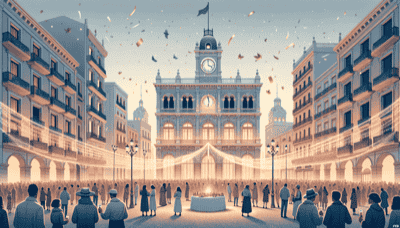We're here to help you keep count of the days to or since a date. Just click the button below and enter your chosen date to get started. Also choose the suggested days or search for a special day above #countingthedays

New Year's Eve, known as "Nochevieja" or "Fin de Año" in Spain, is a day filled with vibrant traditions and celebrations. One of the most famous customs is the eating of the "uvas de la suerte," or the twelve grapes of luck. As the clock strikes midnight, Spaniards eat one grape for each bell toll, symbolizing hope for good luck in the twelve months ahead.
Festivities often begin with family dinners, where special dishes are enjoyed. After dinner, people typically gather in main squares or at home to follow the grape-eating tradition. This is usually broadcast on television from Puerta del Sol in Madrid.
Post-midnight activities include parties with music, dancing, and socializing that can last until dawn. It's common for people to wear fancy attire often accompanied by accessories like wigs and masks.
Major cities host public events with fireworks and shows. The atmosphere is festive and welcoming, with bars and clubs staying open late to accommodate celebrants.
Toasting with cava, Spanish sparkling wine, is another integral part of welcoming the New Year. It's often consumed after eating the grapes at midnight.
There are also various superstitions associated with New Year’s Eve such as wearing red underwear for good luck in love or putting a gold object like a ring in your glass of cava to attract wealth.
In summary, New Year's Eve in Spain is a blend of joyous communal gatherings, unique traditions like grape-eating for good fortune, and lively parties that last into the early hours of January 1st.